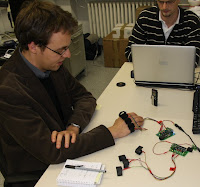
This afternoon Gordon Bolduan from
Technology Review was visiting the lab. We talked about haptic and tactile interfaces and showed some demos (e.g. navigation with tactile cues).
When preparing for the visit I looked for some good examples of tactile interaction – and interestingly there is more and more work out there that has the potential to change future interfaces and means of communication.
Recent work on connecting people [1] and [2] at the boundary between computing and design shows new options for emotional communication.

We used in our work multiple vibration motors and explored the potential for mobile devices [3]. What to use for tactile interaction beyond vibration is one obvious question, and I find the paper by Kevin Li [4] a good starting point to get some more ideas.
When talking about human computer interaction that includes stroking, tapping and rubbing an association to erotic and sexual interactions seem obvious; and there is more to that if you are curious just search for
teledildonics and you will find interesting commercial products as well as a lot of DIY ideas.
[1] Eichhorn, E., Wettach, R., and Hornecker, E. 2008.
A stroking device for spatially separated couples. In Proceedings of the 10th international Conference on Human Computer interaction with Mobile Devices and Services (Amsterdam, The Netherlands, September 02 – 05, 2008). MobileHCI ’08. ACM, New York, NY, 303-306. DOI=
http://doi.acm.org/10.1145/1409240.1409274 [2] Werner, J., Wettach, R., and Hornecker, E. 2008.
United-pulse: feeling your partner’s pulse. In Proceedings of the 10th international Conference on Human Computer interaction with Mobile Devices and Services (Amsterdam, The Netherlands, September 02 – 05, 2008). MobileHCI ’08. ACM, New York, NY, 535-538. DOI=
http://doi.acm.org/10.1145/1409240.1409338 [4] Li, K. A., Baudisch, P., Griswold, W. G., and Hollan, J. D. 2008.
Tapping and rubbing: exploring new dimensions of tactile feedback with voice coil motors. In Proceedings of the 21st Annual ACM Symposium on User interface Software and Technology (Monterey, CA, USA, October 19 – 22, 2008). UIST ’08. ACM, New York, NY, 181-190. DOI=
http://doi.acm.org/10.1145/1449715.1449744








